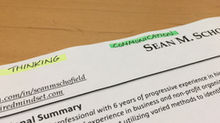Leadership Challenge #20: Tearing Down Silos in Your Organization
- smschofield

- Dec 21, 2023
- 6 min read
Updated: Aug 23
Organizations have remarkably different governance structures. Do you recognize which type of a structure you belong to? There are highly vertical (top-down) leadership strategies, horizontal (more diffuse) leadership structures, and even organizations that believe in shifting power based on projects and strengths of those that make up the team. Much of my leadership experience comes in higher education, which clings very closely to the concept of shared governance. Simply stated, for a project or initiative to move forward in a college or university, it often involves many people that are given stake and influence throughout the process. Organizations are societies. As societies, they provide us the opportunity to dive deeply into an area of specialization (in my case, career development) and contribute to the collective. In all societies, specialists have different priorities, and when resources (time, money, etc.) are scarce, these priorities often appear to compete with one another. One of the largest challenges in an organization that demands buy-in from different (sometimes disparate) groups to move projects forward, is navigating the many silos that threaten collaboration.
Regardless of what type of organization you work in, failure to build coalitions to support your programs will often lead to failure or minimized results. Building these coalitions requires uncovering the priorities of the other specialist stakeholders and forming mutualistic partnerships. To be effective you will need to get political in your leadership, which includes understanding the power dynamics of your organization, forging partnerships, and maintaining relationships with other areas or departments. To illustrate these three priorities I will talk through a program that my former team and I developed and implemented at Muhlenberg College called the Muhlenberg Action Plan (MAP).
The Backstory
My first priority, when entering my role as Executive Director of Career Development was to lead the team through a formal strategic planning process. During this process, we gathered and assessed massive amounts of data, slicing and dicing it in new (and interesting) ways to expose a more disaggregated view of our program and coaching usage by different groups. Like every office that commits to this type of work, we found gaps. Additionally, we performed a robust stakeholder analysis - career centers, being campus-wide offices tend to have many stakeholders - and we were able to begin to develop an understanding of who was an avid supporter of our efforts, and who posed the most significant threat to our programs and success. This 3-month process surfaced the need for a career curriculum (among other things), to intentionally engage students in four years of intentional career education... and the idea for MAP was conceived. At that point, its scope and its success were far from certain. I knew that for us to succeed in making this a campus priority, we were going to need a lot of help, a lot of support, and some robust partnerships. I also recognized our unit had been laying the foundation for these relationships for several years, and that a specific intervention could be the turning point that would bond us with other offices.
Understanding the Power Landscape
Primer Questions:
What people have considerable sway in your organization (both on and away from your team)?
What organizational priorities will get the most attention in the next 2-3 years, and why?
Political power may have ties to job titles, however, leaders must understand that certain voices (regardless of rank) have the power to advance or kill a program on campus. In the case of MAP, I brought my team through a detailed stakeholder analysis and encouraged the team to rate the level of "threat" and "support" that each stakeholder group had. When we began the process of ideating MAP (and at this point, it was not yet called MAP), I brought the stakeholders with high threat and high support into the process very early. My inclination was that if someone could kill a program we wanted to run, the best move was to help that stakeholder feel a sense of ownership of that program. Also, if a stakeholder had demonstrated a propensity to support our programs, they would likely be another voice that could add to our chances of maintaining a majority vote in the planning process. We quickly recognized that in the case of MAP, the highest threat would come not from our home department, but from the faculty. To clarify, this was not due to a feeling that they didn't support us, but in the sense that if our faculty did not support the program, it would be dead in the water. This is an important distinction.
I took the strategy (mind you, this was before any MAP documents were even dreamed up) to the faculty through a "snowball" process (asking one faculty member to identify 2 other faculty members - one whom they believed would support, and one whom they believed would challenge our program). I continued this until I had a decent sample of the faculty population. Once my team began the process of creating the MAP collateral, I was able to bring components of the document to each of those faculty members and get feedback, which I then collected for our editing process. When we had a completed product to begin sharing with other stakeholders (e.g., senior leadership, our advancement division, student affairs, etc.), we knew that faculty had already vetted several of the ideas, and I was able to communicate that in the conversations.
Engaging Other Offices in Deep Collaboration
Primer Questions:
In what ways can you support other offices that will help develop relationships (and yes, curry favor with high-threat or high-support stakeholders)?
How can you ensure (through action) that your priorities are in alignment with other offices that can support your programs?
This next point may feel icky to you, especially early in your leadership practice. As a leader, you must consider the return on your time and energy investments. I have posited, that one of the greatest indicators of whether or not a leader is effective is his/her/their ability to prioritize. When programs require coalitions to be successful, leaders must prioritize relationships that can advance those programs.
You do not have the time or energy to support everyone, and every cause, no matter how "right" they all are.
You need to prioritize which causes you will support, and I believe the best way to do that is by considering which power groups have the greatest ability to support the causes that you care about.
Maintaining the Political Relationship
Like with all networking, the best time to strengthen relationships is when you need nothing from the other person. It's authentic. It's not self-serving. It's something that even new leaders tend to be comfortable doing (because it doesn't feel icky). Once you've established relationships, or have identified people that have power in your organization, work to understand their priorities and needs. Support them and help them to achieve their vision. In other words, treat them how you understand that they want to be treated! This can further help you uncover shared priorities and continue to help you understand how your office and their offices can align themselves for success.
As a new leader in higher education, developing a strong network of connections across your institution will be invaluable. Here are some tips for proactively networking and cultivating relationships across departments, levels, and roles:
Attend campus events and meetings to meet people organically. Introduce yourself to new colleagues and be intentional about following up.
Identify key stakeholders related to your work and schedule one-on-one informational interviews. Ask about their role, priorities, and challenges.
Seek out a mentor (or mentors) who can provide advice and become advocates (sponsors) for you. Choose mentors who have experience navigating campus politics.
Get involved with cross-functional committees and working groups. Use these as opportunities to build rapport and learn institutional knowledge.
Start relationships with peers who are also new to leadership roles. Band together to learn the ropes.
Avoid getting siloed in your department. Connect with leaders in other schools/units to understand interconnectedness. This is important no matter your 'rank' or role.
Leverage connections with colleagues to expand your network. Ask them for introductions to key contacts.
Share knowledge and resources with your connections. Be known for your support.
Stay visible and engaged after making a connection. Follow up and continue building the relationship.
Cultivating a robust network takes effort but is essential for influencing, accessing information, and accelerating your leadership trajectory in higher ed. Spending the time to build relationships and bust down siloes will lead to more successful programming, easier and more natural relationships for your team, and help you align yourself with the institutional mission and priorities. In our story, MAP has been successful not solely because of the brilliance of the product that my team created, but in large part because these relational alignments allowed us to continue to grow our influence within other divisions of the College. First-year appointments have reached 95 percent (directly due to partnerships with the Dean of Students Office), and we utilize these appointments to introduce MAP to each new student at Muhlenberg. Additionally, as we continue to engage with faculty and other departments, our office's influence is reaching the academic curriculum, and the College Life (Student Affairs) curriculum. Our MAP rollout also plays a significant role in the fundraising that our Advancement team performs to support our experiential programs and initiatives.
I am happy to talk more about this wildly successful program, but I also am interested to get your feedback (as always)!





![The Three Most Important Tools in the [Insert Role Here] Toolbox](https://static.wixstatic.com/media/95563e_ea80203fa49e4ce8973aad36dc9d82e0~mv2.png/v1/fill/w_447,h_250,fp_0.50_0.50,q_35,blur_30,enc_avif,quality_auto/95563e_ea80203fa49e4ce8973aad36dc9d82e0~mv2.webp)
![The Three Most Important Tools in the [Insert Role Here] Toolbox](https://static.wixstatic.com/media/95563e_ea80203fa49e4ce8973aad36dc9d82e0~mv2.png/v1/fill/w_220,h_123,fp_0.50_0.50,q_95,enc_avif,quality_auto/95563e_ea80203fa49e4ce8973aad36dc9d82e0~mv2.webp)
































Comments